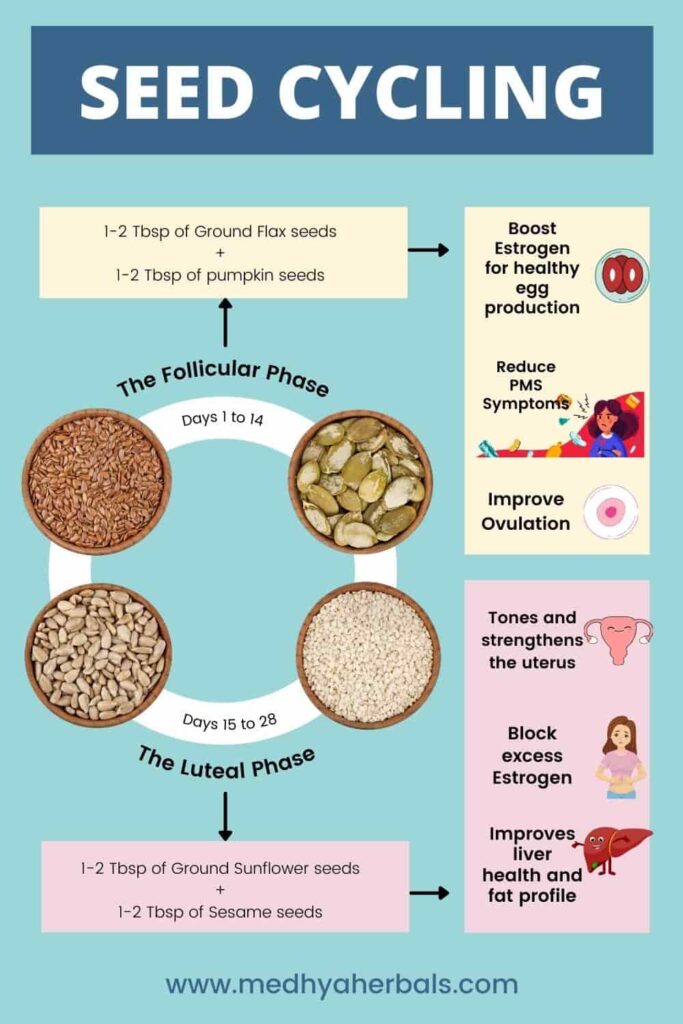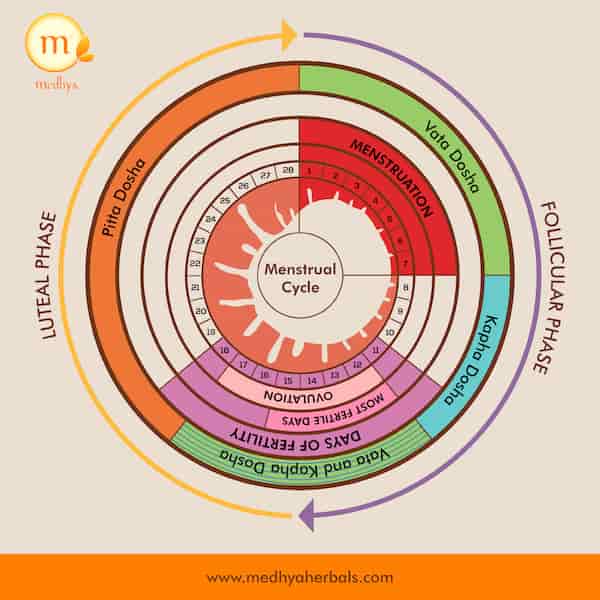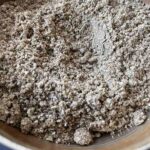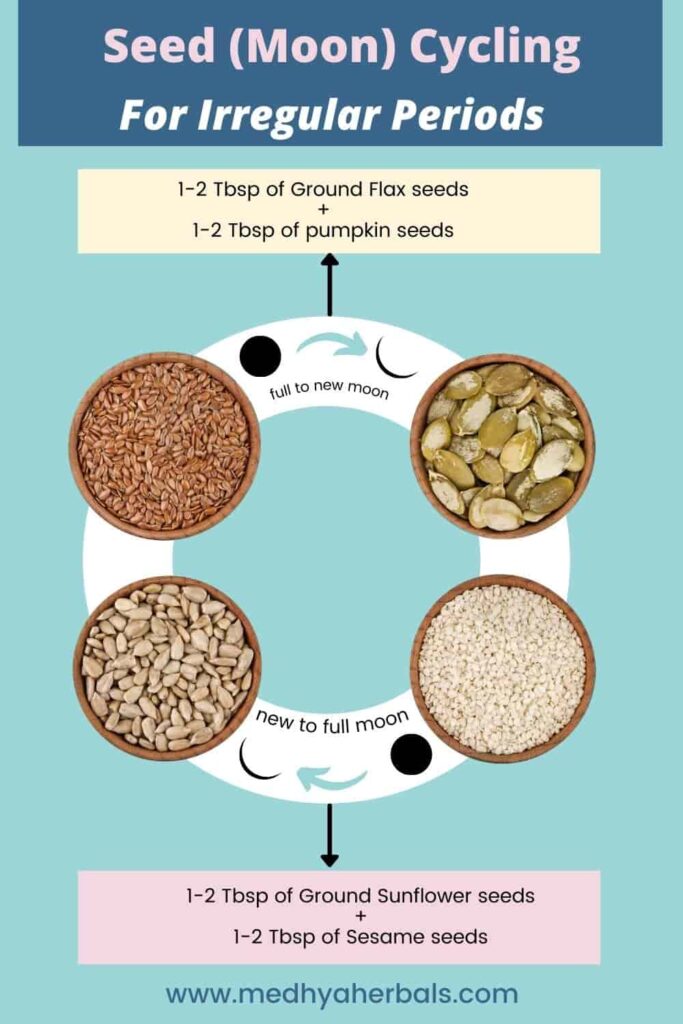Seed Cycling is a nutrition based approach to balance hormones. It is also a traditional way to boost fertility and regulate menstrual cycle by tapping on the benefits of mighty seeds.
Seeds are plentiful source of antioxidants, phytoestrogens (plant based estrogens), healthy fatty acids, vitamins and minerals. They support healthy hormone production, hormone balance and communication (hormone binding).
A variety of seeds find mention in many Ayurvedic formulations for female reproductive and fertility disorders. Some of them include black sesame seeds, pumpkin seeds, lotus seeds, flax seeds and Mucuna Pruriens (konch ke beej).
And when you selectively consume them as done in seed cycling, you experience the wonders of nutrition and balance.
In this post, we will learn about the benefits of seed cycling, how to start introducing seeds for regular periods, best time to seed cycle and two delicious recipes.
What is seed cycling?

Seed cycling means rotation of seeds in your diet according to the phase of your menstrual cycle.
This cycling of seeds is essentially based on the requirement and flow of reproductive hormones (Estrogen and Progesterone) during the menstrual cycle. And this is how seed cycling looks like:
- Taking 1-2 tablespoons of ground flax seeds and pumpkin seeds in Follicular phase (Days 1-14) of your menstrual cycle; and
- Taking 1-2 tablespoons of ground sunflower seeds and ground sesame seeds in Luteal phase (Days 15-28) of your menstrual cycle.
I’m sure you’re now wondering: why, what’s the point of that? You will understand this better by the time you get an overview of the menstrual cycle.
The Essential Link: Seed Cycling, Hormones and Your Menstrual Cycle
A woman experiences cycling (up and down) of her reproductive hormones during her menstrual cycle. This rhythmic flow of her hormones helps to prepare her body for different actions, experienced during ovulation and menstruation.
And accordingly, her menstrual cycle is divided into 2 main phases:
The Follicular Phase: From Menstruation till Ovulation
In a typical 28-day cycle, the follicular phase lasts from Day 1 (time when menstruation starts) to Day 14 (around the time of ovulation) of your menstrual cycle. During this phase, Estrogen hormone rises and Progesterone is maintained low.
In Follicular phase, Estrogen hormone helps in the growth and maturation of the egg from follicles. This leads to healthy egg release during ovulation.
That’s why, Estrogen rich foods and seeds such as pumpkin seeds and flax seeds should be consumed daily in the Follicular phase. Others include:
- 1-2 tablespoons of chia seeds
- High-quality fish oil (optional)
- 2000mg EPA/DHA
The Luteal Phase: From Ovulation till Menstruation
The Luteal phase lasts from Day 15 (after ovulation) to Day 28 (until your flow starts) of your menstrual cycle. During this phase, Progesterone hormone rises and Estrogen is maintained low.
In Luteal phase, Progesterone hormone helps a woman’s body to prepare for the expected pregnancy. It also nourishes the uterine lining.
That’s why, Progesterone rich foods and seeds such as sesame seeds and sunflower seeds are consumed daily in the Luteal phase. These seeds also block excess Estrogen so that Progesterone can function well. Others include:
- 1000mg EPA/DHA
- 500mg Evening primrose oil
You can picture your hormone levels in a menstrual cycle as a seesaw, moving from one side to the other. If it should fall off to one side, there will be problems for sure.
Thankfully, seed cycling can help you keep this seesaw in balance.

Why should there be hormone imbalances in the first place?
Naturally, a woman’s body system can take cues to regulate the hormones as necessary. Unfortunately, it is not always a smooth ride. Some factors can cause hormonal imbalances to occur. Some of them are:
- Excessive exercising
- Stress
- Poor Diet and Nutrition
- Obesity
- Being underweight
- Menopause
- PCOS
- Hypothyroidism
Even if you do not have any of these health problems, you can still benefit greatly from supporting your hormones with seed cycling.
Seed Cycling Benefits
Seed cycling is a highly effective way to introduce the right amount, type and quality of essential nutrients in your meals.
Along with right diet and lifestyle, seed cycling can really help in health disorders such as hormone imbalance, PCOS, Irregular Periods and Menopause Symptoms.
Here are the health benefits of seeds that are consumed during seed cycling:
1. Flax Seeds
Flax seeds contain phytoestrogens, which act like estrogens in the body.
They also contain lignans. These can help bind excess estrogens, thereby preventing estrogen levels from getting too high.
Research shows that flax seeds help in lengthening the luteal phase. They also help to improve ovulation and in reducing common PMS symptoms such as breast pain and cramping.
Flax seeds contain omega-3 fatty acids. These promote blood flow to the uterus. It helps to increase progesterone secretion (in preparation for the Luteal Phase) and helps to maintain healthy cell membranes.
2. Pumpkin Seeds
Pumpkin is rich in zinc. This helps in preparing the body for the next stage of the menstrual cycle and eventual pregnancy.
Pumpkin seeds contain omega-3 fatty acids as well.
3. Sesame Seeds
Sesame seeds also contain lignans which help to block excess estrogen.
Zinc is present in high concentrations of sesame seeds and it helps to improve the formation of the corpus luteum. The corpus luteum produces progesterone and stimulates the uterus to thicken in preparation for pregnancy.
Postmenopausal women have a lot to gain from sesame seeds. They improve blood lipids, antioxidants, and sex hormones.
4. Sunflower Seeds
Sunflower seeds contain high levels of selenium(a trace mineral), which supports estrogen detoxification in the liver. The benefit of this is that it suppresses estrogen during the luteal phase.
5. Hormone Production and Ovulation
All four seeds, i.e. flax, pumpkin, sesame, and sunflower seeds have individual benefits. Yet, they have another in common.
This is that they all contain Vitamin E, omega-3, and omega-6 fatty acids. The vitamin and fatty acids are essential for hormone production and follicle function.
Therefore, we can conclude that they influence hormones.
6. Seed Cycling Benefits in Menopausal Women
Menopausal women are susceptible to hormonal imbalances. These can lead to a host of undesirable effects. For example, as estrogen levels drop, they can experience osteoporosis (weakened bones).
Consequently, they are at risk of fractures. However, seed cycling can help in maintaining hormone balances.
Flax seeds have been linked to slight increases in estrogen. It helps with improved hormone metabolism, fewer hot flashes, reduced vaginal dryness, and better overall quality of life in menopausal and postmenopausal women.
7. Nutrition and Food Cravings
- They contain fibers and proteins.
- Seeds help reduce sugar cravings.
- They support healthy cholesterol levels.
How to use and/or consume the seeds?
There is a great deal of liberty to how you can use the seeds. It all depends on your preference.
Incorporating the seeds into your lifestyle/diet
It might seem daunting to start this new way of life. It might almost seem like relocating. You might be scared of committing yourself to this, even.
But, once you’re able to incorporate it, it becomes a part of you, almost second nature. You begin to do it reflexively, without even thinking about it.
Here are a few ways you can include the seeds in your daily meals:
- Add to smoothies, curd, oatmeal, or puddings
- Add to flours and grain preparations
- Make dry seed powders with herbs and add them to your meals
- Sprinkle on toast, nourish bowls, salads, or soups and vegetables.
- Make homemade granola with pumpkin and flax or sesame and sesame seeds
- Pesto with pumpkin and flax seeds
- Homemade seed butter
Seed Cycling Recipes
Seed cycling recipes provided here give you a quick idea to make delicious food items from the nutrient dense seeds. You can exchange the seeds in both the recipes while keeping rest of the ingredients in similar proportion.
Just remember that pumpkin and flax seeds are slightly bitter, so you may need to add something naturally sweet such as coconut as we have done to make the recipe palatable.
1. Pumpkin Seeds and Flax Seeds Dry Chutney Powder with Curry Leaves for Follicular Phase (Days 1 -14)
Pumpkin Seeds and Flax Seeds Dry Chutney Powder with Curry Leaves

An extremely delicious and highly nutritious chutney powder. Mixed with ghee, it makes for a delicious and high nutritious sauce. This recipe is recommended for all age groups. It is helpful for hormone balance in women.
- Grinder
- Pan
- ½ cup Flax Seeds
- ½ cup Pumpkin Seeds
- 2 tbsp Dry curry leaves powder (Replace with Moringa powder)
- 1 tbsp Cumin Seeds (Or Roasted and Ground Cumin Seeds powder)
- 1 tbsp Dry Mango Powder
- 2 tsp Rock Salt (To taste)
- 2 tsp Black Pepper Powder
- ¼ cup Desiccated Coconut Powder
Dry roast flax seeds and pumpkin seeds on low heat. Leave them aside to cool down.
Dry roast cumin seeds and keep them aside.
Now grind the seeds together to make a smooth powder.
Mix all the ingredients to make your delicious podi powder.
Refrigerate it or store in an air tight container.
You can make dry curry leaves powder either by drying curry leaves (in the sun). Or you can quickly dry roast fresh curry leaves, let them cool down, and then grind to make the powder.
1/2 cup of fresh curry leaves will give 2 tbsp of powder.
2. Sesame and Sunflower Seeds Dip for Luteal Phase (Days 15 – 28)
Sesame and Sunflower Seeds Butter

This recipe of sesame and sunflower seeds is a delicious way to tap on the nutrition and benefits of seeds. It is great for all age groups, specifically for women to promote hormone balance. You can make it quickly and add it to your meals or sides.
- Grinder or Blender
- ½ cup Sesame Seeds (Raw and Unhulled)
- ½ cup Sunflower Seeds (Raw and Hulled)
- 1 tbsp Lemon or Lime Juice
- 1½ tsp Rock Salt
- 1½ tsp Roasted cumin powder
- 1 tsp Black pepper
- 2 cloves Garlic
- ½ tsp Dry ginger powder (optional)
- 1 tsp Dry onion powder (optional)
- 1 cup Warm water
- 2-3 Sprigs Fresh coriander leaves
Soak the Seeds together in warm water for about 30 mins. Alternatively, you can soak them in normal water for 2-3 hours.
Peel garlic and keep aside. Fonely chop the coriander leaves.
Now, strain the seeds and keep the water in a separate bowl.
Blend the seeds and rest of the ingredients to make a smooth paste for consistency that you need. Use the water in the bowl per your needs.
Garnish with coriander leaves.
Enjoy with bread, chapati, dosa or pancake.
Seed Cycling when your Menstrual Cycle is not 28 Days
The average cycle is 28 days, but it’s not so for all women. After all, it’s only an average value.
Menstrual cycles can range between 21 and 35 days. Just split the length of your cycle in two accordingly.
If you have a 21-day cycle for example, then your Follicular phase should be about Days 1-11, and your Luteal Phase should be about Days 11-21.
How to Seed Cycle with Irregular Periods and PCOS?

If you have irregular cycles, it might be difficult to ascertain your Follicular and Luteal phases. In that case, you can do something called Moon Cycling instead.
Seed Cycling with Moon | How Does it Work?
Moon cycling is the act of tracking your menstrual cycle using the moon as a reference point.
This is how moon cycling and seed cycling are related:
- Full Moon: You can take this as the beginning of the first phase of your menstrual cycle. Thus, you are in the Follicular Phase of your menstrual cycle, and you should take the appropriate seeds for the period, i.e. flax seeds and pumpkin seeds.
- New Moon: Take this to mark the beginning of the second phase. You are in the Luteal Phase when you see the full moon. Take the corresponding seeds for this period also, namely sesame seeds and sunflower seeds.
Does Seed Cycling really help to Balance Hormones?
All well and good, you’ve learned about seed cycling and how you can make it work. But, now to the big question, does it actually work?
Well, some discredit seed cycling, others are skeptical, while yet others attest to its efficacy. Some research has shown that it does work, while others could not reach any conclusive results. Evidently, a lot more research still needs to be done.
However, we cannot deny the fact that these seeds are loaded with ingredients with amazing benefits. Some of them are summarized in the tables above.
Also, you need to note that seed cycling is not a quick fix. It is a way to improve your diet and nutrition. Usually, you can expect to observe seed cycling benefits after 3-4 months of regular practice.
A few takeaway tips on seed cycling
- You should grind the seeds with a coffee grinder for example. This helps you digest them better.
- Don’t grind a lot to store for a long time. Only make sufficient for a few days at a time to keep the ground seeds fresh.
- Store seeds in an air-tight container.
- Keep your seeds refrigerated.
- Use raw and organic seeds. Don’t fry or salt or do any such thing. These agents can damage the components of the seeds that you need.
- Keep your dosage between one and two tablespoons per day and keep to that consistently.
- Make sure you don’t have any allergies to these seeds and ensure you can digest them without any problems.
- Keep in mind that seed-cycling isn’t the grand cure. You need to eat healthily, sleep healthy, and have a overall healthy lifestyle.
Other Natural and Ayurvedic Ways for Hormone Balance
Ayurveda is a holistic medical science, which involves complete wellness of body, mind and spirit.
You do not need any synthetic, artificial medications to stay healthy! Nature has provided all you need, and Ayurveda can teach you how to harness this power of nature for health.
Aside from seed cycling, there are still myriads of tips and tricks in Ayurvedic medicine to maintain or restore your hormone balance naturally. To name a few such herbs:
- Phytoestrogens: We have mentioned this earlier. However, phytoestrogens are also present in red clover, sage, hops, Shatavari, fenugreek, and motherwort.
- Adaptogens: They are general tonics for reproductive health and mood that may benefit both estrogen and progesterone balance. As a bonus, they can also boost libido and decrease anxiety too. Some are maca, shatavari and damiana.
- Vitex: This helps boost progesterone and prevent PMS, mood swings, breast tenderness, and other unpleasant symptoms.
- Bitters: Bitter foods and herbs such as leafy greens, curry leaves, watercress, moringa leaves as well as broccoli family. These liver healthy foods encourage help to detoxify naturally, boost metabolism and flush out excess hormones.
- Fibers: They bind to the liver’s waste (bile) for better excretion through the feces. Fibers are present in whole grains, roots, beans, nuts, seeds.
Now, we want to hear from you. Do write to us for any queries and feedback. We will get back to you the soonest. What has been your experience with seed cycling? What worked and what didn’t. Do share your thoughts and story with us.
Wishing you vibrant health!
REFERENCES:


so useful and beautiful knowledge shared by you. if we roast the seeds and then ground it and consume it with hot milk is it recommended . i used to give but your seed cycling has increased my knowledge about giving what and when. do guide me . thanks for your knowledge and sharing it. my daughter all the four seeds at a time everyday roasting it grounding and adding in hot milk
Thanks Rooma, happy to know that the post is helpful 🙂 Regarding your query, it is alright to give all the 4 seeds roasted and mixed together along with milk. However, this would be recommended for general health upkeep. You’ll have to limit the quantity of each seed and bring it to 1/4 in equal mix. Make sure to not exceed the daily quantity as it can increase Pitta/Kapha in the body.
But, if you are giving seeds for balancing hormones, then they will be more effective when given according to the cycle and mixing them according to the phase. Hope it helps.
Hello! I just recently started seed cycling yesterday. I’ve been doing a bunch of research but haven’t been able to find an answer. I would ideally like my cycle to align with the moon although I just started my cycle yesterday. My cycles have been irregular, lasting 38-45 days. I wanted to naturally regulate them, although I’m not sure when to start the new seeds given I don’t have a regular cycle and my cycle currently doesn’t align with the moon. Starting yesterday I took ground flax and pumpkin in a smoothie, but I’m not sure when to start the next set of seeds. Thank you for your article!
Hi Bailley, when you are trying to seed cycle with the moon cycle, then the process is kind of exactly the same as it will be if the cycle is in synch already. So, consider new moon to full moon as the follicular phase and go with flax and pumpkin seeds. And from full moon to new moon (consider this as the luteal phase) go with sesame and sunflower seeds.
Do add in digestive spices and herbs to make your seed cycle recipes even more beneficial.